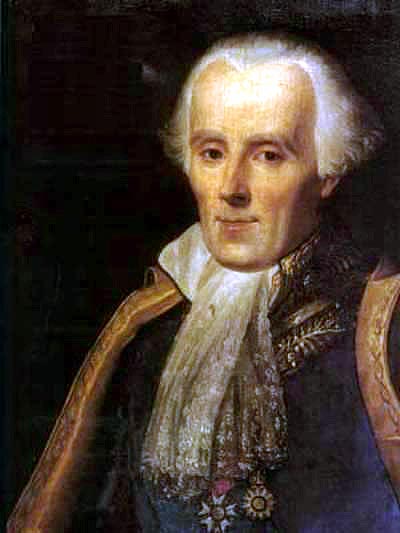Class 14: Can we predict the future?
Computing for Molecular Biology 2
Andrés Aravena, PhD
30 April 2021
Dynamic Systems
The missing parts
We have seen the main ideas about dynamical systems
We can simulate systems with time advancing step-by-step
(time is an integer number)
Later, if we have time, we will see other tools that work when time is continuous
(i.e. when time is a real number)
What we have seen so far
- Dynamic systems allow us to model complex things
- decomposition in parts
- describe the interactions
- Simulating dynamical systems shows us
- what will happen
- what happened before
Pierre-Simon Laplace (1749–1827)

French mathematician and astronomer
Laplace said
“An intelligence knowing all the forces acting in nature at a given instant, as well as the momentary positions of all things in the universe, would be able to comprehend in one single formula the motions of the largest bodies as well as the lightest atoms in the world; to it nothing would be uncertain, the future as well as the past would be present to its eyes.”
If we know the current state…
“An intelligence knowing all the forces acting in nature at a given instant, as well as the momentary positions of all things in the universe, would be able to comprehend in one single formula the motions of the largest bodies as well as the lightest atoms in the world; to it nothing would be uncertain, the future as well as the past would be present to its eyes.”
…and we know the system…
“An intelligence knowing all the forces acting in nature at a given instant, as well as the momentary positions of all things in the universe, would be able to comprehend in one single formula the motions of the largest bodies as well as the lightest atoms in the world; to it nothing would be uncertain, the future as well as the past would be present to its eyes.”
…then we can know the future and the past
“An intelligence knowing all the forces acting in nature at a given instant, as well as the momentary positions of all things in the universe, would be able to comprehend in one single formula the motions of the largest bodies as well as the lightest atoms in the world; to it nothing would be uncertain, the future as well as the past would be present to its eyes.”
Let’s say it again
“all the forces acting in nature at a given instant, as well as the momentary positions of all things in the universe”
If we know the current state …
“would be able to comprehend in one single formula the motions of the largest bodies as well as the lightest atoms in the world
And we know the system…
“nothing would be uncertain, the future as well as the past would be present”
Then we can know exactly what is in the future
These are deterministic systems
All the future is determined by the initial state and the system rules
Can we really predict the future?
Sometimes we can predict
Sometimes models are too simple and they miss important parts
If the system is realistic, we can predict
We need to measure initial values and rates
But all measurements have a margin of error
What if we don’t know the exact value?
In real life we cannot measure exact values
We can only measure within a margin of error
For example, when we measure 2.0 mol of Hydrogen, it may be 1.95 or 2.05 or any value in between
Inaccurate measurement of H_ini
Small initial errors give small final errors
Effect of error on r1_rate evaluation
Small changes in the initial state produce small changes in final state
Even if we make errors, their effect is not very important
Another system: Quadratic map
- A population that reproduces and dies
- Death happens in pairs (two incoming arrows)
- They die of overcrowding
- This is a model of a population with limited space
Another system: Quadratic map
To study this system, we will assume that death rate and birth rate depend on a single value A
- Death rate is A/2
- Birth rate is A-1
- If we know A, we know birth and dead rate
Formulas are easy to find
in other words
so finally
and the program is also easy to write
We simulate for different initial conditions
x_ini <- c(0.4, 0.45, 0.5, 0.55, 0.6)
ans <- data.frame(V1=quad_map(N=100, x_ini=x_ini[1], A=2))
plot(ans$V1, ylim=c(0,1), ylab="x", type="b")
for(i in 2:length(x_ini)) {
ans[[i]] <- quad_map(N=100, x_ini=x_ini[i], A=2)
points(ans[[i]], pch=i, type="b")
}The final state is always the same
This is called attractor
Behavior depends on A. Here A=3
Now there are two final states.
This is a periodic attractor
Behavior depends on A. Here A=3.5
Now we have four final states.
Also a periodic attractor
Behavior depends on A. Here A=3.8
We do not see a pattern here
Behavior depends on A. Here A=3.95
Similar initial states, very different results
Small changes in x_ini, big changes in result
Initial values:
[1] 0.40 0.45 0.50 0.55 0.60Final values:
V1 V2 V3 V4 V5
100 0.07712169 0.7034133 0.8541633 0.7034133 0.4900459We cannot predict
well, not always
This is called “Butterfly Effect”
The fly of a butterfly in Istanbul can produce an hurricane in Mexico
Small changes have big consequences
But we can still say something
We cannot make exact predictions
But we can still say what is normal
What is the most probable behavior
We can identify patterns using the tools of …. (sound of drums)